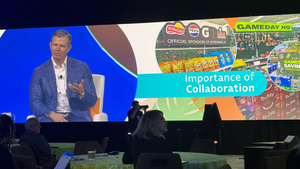Amazon’s sales jump in Q3, but not at physical storesAmazon’s sales jump in Q3, but not at physical stores
Brick-and-mortar retail outlets see quarter-to-quarter decrease
October 26, 2018
Amazon.com Inc. topped Wall Street’s earnings forecast for the third quarter but fell short of analysts’ revenue projections, even as sales surged nearly 30%.
Meanwhile, the e-tail giant saw a quarter-to-quarter decline in sales at physical stores, which include Whole Foods Market. That marked the second time in the past three quarters (including a full contribution from Whole Foods) that physical stores had a sequential decrease.
For the third quarter ended Sept. 30, Amazon totaled sales of $56.58 billion, up 29% from $43.74 billion a year earlier. Sales in North America rose 35% to $34.35 billion from $25.45 billion. Online sales climbed 10% year over year to $29.06 billion from $26.39 billion.
At physical stores in the third quarter, Amazon recorded its lowest sales total so far this fiscal year, with revenue of nearly $4.25 billion, down 1.5% from just over $4.31 billion in the previous quarter. No direct year-over-year comparison was available for physical stores since the Whole Foods acquisition closed during the latter half of 2017 third quarter (on Aug. 28) and only included a partial sales contribution from the grocery chain.
“I think we've started to show our strategy on the Whole Foods side. You'll see even this quarter we started to have greater expansion of our grocery delivery out of Whole Foods using Prime Now,” Amazon Chief Financial Officer Brian Olsavsky told analysts in a conference call late Thursday. “We're now in 60 cities in the U.S., giving customers delivery in as fast as an hour on thousands of great organic products from Whole Foods.”
Currently, Amazon has 603 physical stores, including 492 Whole Foods locations (472 in the United States), six Amazon Go convenience stores, 18 Amazon Books stores, one Amazon 4-Star outlet and 86 Amazon Pop-Up sites.
“On the store front, we're experimenting with numerous store formats,” Olsavsky said. Amazon Go is now up to six stores. We opened five in the quarter. We're getting great feedback on that. Customers love the ability to quickly walk in, select items they want and leave without waiting in a checkout line. We opened up an Amazon 4-Star location in New York City, where we're going to test the concept of a highly curated selection of top categories across Amazon. We, of course, have Amazon Books stores, 18 bookstores in the U.S. So we're going to experiment with multiple ways of reaching the customer, wherever they happen to be.”

Amazon doesn’t break out sales data for Whole Foods in its quarterly reports. According to panelists at the SN Financial Analysts Roundtable, held in mid-September, that has made it tough to assess what kind of lift Whole Foods may have received from the acquisition by Amazon.
“It's certainly difficult to still get a grasp on what or how Whole Foods is necessarily performing. They turned positive after multiple years of negative same-store sales, and they had slowed down growth up until recently, when [founder John] Mackey declared that they're going to accelerate unit growth again. But have they been outright successful?” Jefferies analyst Christopher Mandeville said at the event.
“I don't think that necessarily, from a sales perspective, Amazon-Whole Foods has been overly successful,” he added. “I think it has been more about dictating the game and the narrative with respect to how much all of the [grocery retail] incumbents need to invest and how Amazon has AWS [Amazon Web Services] to rely upon in terms of driving profitability.”
What might be coming up for Whole Foods is more in-store automation, leveraging Amazon’s “Just Walk Out” technology used in the cashierless shopping experience at Amazon Go, Mandeville suggested. “I'd venture a guess it won't be too long before we start seeing elements of that in a Whole Foods test pilot, similar to what we see with the Go concept but on a larger scale,” he said.
At the bottom line in the 2018 third quarter, Amazon reported net earnings of $2.88 billion, or $5.75 per diluted share, compared with $256 million, or 52 cents per diluted share, a year ago.
Analysts, on average, had projected earnings per share of $3.14, with estimates ranging from a low of $2.25 to a high of $4.40, according to Thomson Reuters.
“Amazon Business has now reached a $10 billion annual sales run rate and is serving millions of private and public-sector organizations in eight countries. “And we’re not slowing down: Amazon Business is adding customers rapidly, including large educational institutions, local governments and more than half of the Fortune 100,” Amazon founder and CEO Jeff Bezos said in a statement. “These organizations are choosing Amazon Business because it increases transparency into business spending and streamlines purchasing, with increased control. The team is doing a fantastic job building and innovating for customers.”
About the Author
You May Also Like






